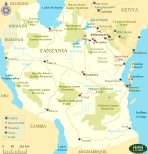|
Ngorongoro Crater
At 2286 metres above sea level, Ngorongoro Crater is the largest intact caldera in the world. With a crater floor about 16-20 kms across, and an area of 259 sq kilometers, with steep surrounding walls, Ngorongoro
is a scenic, natural enclosure for thousands of wild animals and hundreds of bird species.
Ngorongoro Crater is one of the last remaining areas in Tanzania where one can see the endangered Black Rhino: a small population is thriving in this idyllic and protected environment, and it remains one of the few areas where they continue to breed in the wild. |
|
Ngorongoro Conservation area encompasses the crater and the surrounding area, forming a wildlife sanctuary. The crater itself is the remains of a once massive volcano, nearly three million years old, on the eastern border of the Serengeti National Park. Now collapsed and eroded, its volcanic origins make it a fertile ‘bowl’ in the midst of rolling highlands, with permanent water sources and steep sides ensuring that the wildlife that thrives here has little reason to leave.
It is the stalking ground of around 20,000 - 30,000 wild animals at any one time, the most densely packed concentration of wildlife in Africa, and remains one of the most perfectly formed and certainly the most spectacular calderas on the planet.
The Crater comprises areas of grassland, swamps, lerai forest (small patches of forest made up of yellow-barked acacia and yellow fever trees), and Lake Makat, a central soda lake filled by the Munge river. |
 |


